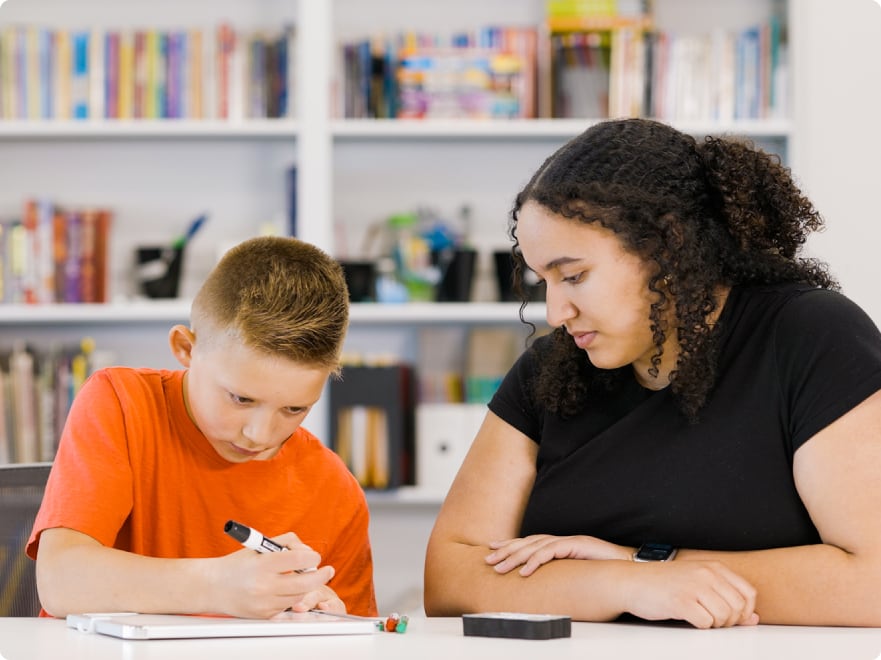Step 1
Review previous concepts
The activities in Step 1 are intended to help students build automaticity with recognizing graphemes and phonemes and to build phonemic awareness.
Review and warm-up drills
Visual drills

Use grapheme letter cards with known graphemes and ask the student to identify all the sounds they know that grapheme can make (e.g., ‘C’ = /k/, /s/). Move quickly through these!
Auditory drill

Say/Dictate letter sounds and ask the student to write the corresponding graphemes (e.g., /k/ = ‘c’, ‘k’, ‘ck’)
Blending drill

Use grapheme cards with known graphemes. Organize by initial, medial and final sounds. Guide student(s) in saying each sound and then blending the three sounds into a word (or pseudoword).
- Make new words by changing one letter or grapheme at a time.
- Continue the process to make more new words, alternating between changing the initial, medial, and final positions.
Phonological and phonemic awareness
Phonemic awareness is the ability to notice and manipulate individual sounds in spoken words. It’s very important for learning to read, especially learning to blend and segment individual sounds in words.
Phonological awareness is an umbrella term that includes phonemic awareness and also skills such as the ability to recognize parts of spoken words like rhymes, syllables, and alliteration.
Use these activities to help your student build phonemic and phonological awareness skills.
- Partial alphabetic phase
- Full alphabetic phase
- Consolidated alphabetic phase
Heggerty
The Heggerty Primary Phonemic Awareness Curriculum helps students to hear the sounds in words which then helps them to read and spell words. The curriculum includes 24 weeks of lessons with 10 skills in each lesson. Based upon the Alberta English Language Arts and Literature curriculum, we suggest you prioritize four of these skills: rhyming, blending, segmenting and deleting.
The following example is from Week 17: Monday.
Rhyming
| Rhyme production |
|---|
| Teacher says a word and students say about 3 rhyming words. |
| Monday – Week 17 |
|---|
| My (shy, fly, cry, try) |
| Sip (ship, trip, clip) |
| Low (blow, glow, show) |
Blending
| Blending Phonemes |
|---|
| Teacher says the phonemes for each word. Students blend the sounds to say the whole word. Ex. Teacher: “b-r-ā-d” Student: “braid” *say sounds, not letter names |
| Monday – Week 17 | |
|---|---|
| b-r-ā-d | braid |
| c-r-ă-b | crab |
| g-r-ī-n-d | grind |
| f-r-ē | free |
| g-r-ă-s | grass |
| p-r-ĭ-n-t | |
| g-r-ou-n-d | ground |
| b-r-ā-n | brain |
| c-r-ă-sh | crash |
| p-r-oo-f | proof |
Teacher places palms together to create “choppers.” The teachers chops from right to left, one chop per phoneme, then slides hands right to left to say the whole word.
Segmenting
| Segmenting Phonemes |
|---|
| Teacher says the word. Students repeat the word and segment it into phonemes. Ex. Teacher: “praise” Student: “praise, p-r-ā-z” *students say sounds, not letter names |
| Monday – Week 17 | |
|---|---|
| Greet | g-r-ē -t |
| Brush | b-r-ŭ-sh |
| Crop | c-r-ŏ-p |
| Brunch | b-r-ŭ-n-ch |
| Frog | f-r-ŏ-g |
| Grand | g-r-ă-n-d |
| Press | p-r-ĕ-s |
| Fresh | f-r-ĕ-sh |
| Broke | b-r-ō-k |
| Cramp | c-r-ă-m-p |
Students place palms together to create “choppers” and make a chopping motion from left to right as they say each phoneme in the word.
Deleting
.
| Deleting Initial Phonemes |
|---|
| Teacher says a word and students say about 3 rhyming words. |
Monday – Week 17
| Word | Without | Response |
|---|---|---|
| pride | /p/ | Ride |
| fry | /f/ | Rye |
| gray | /g/ | Ray |
| praise | /p/ | Raise |
| bright | /b/ | Right |
| crust | /c/ | Rust |
| fruit | /f/ | Root |
| prod | /p/ | Rod |
| froze | /f/ | Rose |
| crown | /c/ | rŏwn |
Deleting hand motion: Hold 2 open palms out in front of you. Teacher’s right hand is the first sound, left hand is the rest of the word. Pull your right hand away when deleting the first sound, and show what parts remains with your left hand.
Resources
Heggerty Phonemic Awareness – YouTube – Includes more demonstration videos.
Do some oral blending and segmenting with words that include the new concept you are teaching.
For example, for UFLI Lesson 41c, have your student blend and segment some short vowel words.
Blend
Turtle talk to motor mouth – You will orally segment one word into its individual phonemes (stretch it out in “turtle talk”) and the student will blend them to make the word (“motor mouth”).
Eg. /s/ /l/ /o/ /p/ – “slop”
Segment
Motor mouth to turtle talk. You will say a word and the student will orally segment that word into individual phonemes.
Eg. “List” – /l/ /i/ /s/ /t/
Kilpatrick’s Phonemic Awareness Lessons
Use Kilpatrick’s One Minute Exercises (not using the new phonics concept) to help students orally manipulate phonemes in words. Begin with Level J. Your student should be able to move through one single section (e.g., Level J #3) in 60 seconds with almost no errors. If they can, move on to a more challenging level next time.
Kilpatrick One Minute Exercises are similar to Heggerty Phonemic Awareness lessons but Kilpatrick includes more challenging phonemic awareness skills.
Phonological and phonemic awareness tips
Follow this link to a Google Doc that includes activities to enrich Phonemic Awareness.
Play some of the 2Fun4Words games from the Lit Kit to build phonemic awareness.